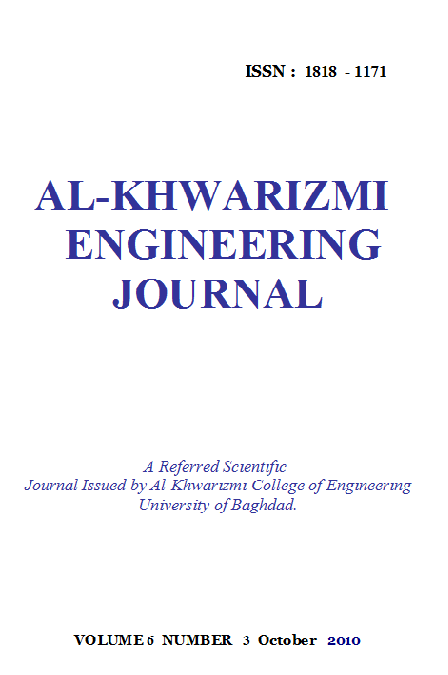Guiding Mobile Robot by Applying Fuzzy Approach on Sonar Sensors
Abstract
This study describes how fuzzy logic control FLC can be applied to sonars of mobile robot. The fuzzy logic approach has effects on the navigation of mobile robots in a partially known environment that are used in different industrial and society applications. The fuzzy logic provides a mechanism for combining sensor data from all sonar sensors which present different information. The FLC approach is achieved by means of Fuzzy Decision Making method type of fuzzy logic controller. The proposed controller is responsible for the obstacle avoidance of the mobile robot while traveling through a map from a home point to a goal point. The FLC is built as a subprogram based on the intelligent architecture (IA). The software program uses the Advanced Robotics Interface for Applications (ARIA), it is programmed with C++ package ( Visual C++.Net ), and Networking software is used for setup Wireless TCP/IP Ethernet-to-Serial connection between robot and PC. The results show that the developed mobile robot travels successfully from one location to another and reaches its goal after avoiding all obstacles that are located in its way. The platform mobile robot is a Pioneer 3 DX that is equipped with Sonar sensors.
Downloads
References
[2] Pioneer reference book, www.mobilerobotics. com. 2008.
[3] Kevin M. Passino, Stephen Yurkovich, ''Fuzzy Control'', Addition Wesley Longman,Inc., California, 1998.
[4] Hani Hagras, Victor Callaghan, Martin Colley, ''Learning and adaptation of an intelligent mobile robot navigator operating in unstructured environment based on a novel online Fuzzy–Genetic system'', Fuzzy Sets and Systems, Vol. 141, pp.107–160, 2004.
[5] Jang Hyun Kim1, Jin Bae Park2, and Hyunseok Yang, ''Implementation of the Avoidance Algorithm for Autonomous Mobile Robots Using Fuzzy Rules'', LNAI, Vol. 4223, pp. 836–845, 2006.
[6] Vamsi Mohan, Dan Simonm, ''FUZZY LOGIC CONTROL FOR AN AUTONOMOUS ROBOT'', 2004.
[7] Rerngwut Choomuang , Nitin Afzulpurkar , '' Hybrid Kalman Filter/Fuzzy Logic based Position Control of Autonomous Mobile Robot'', International Journal of Advanced Robotic Systems, Vol. 2, pp. 197 - 208, 2005.
[8] Elie Maaloufa, Maarouf Saada, ''A higher level path tracking controller for a four-wheel differentially steered mobile robot'', Robotics and Autonomous Systems, Vol.54, pp. 23–33, October, 2005.
[9] K.A.Hawick and H.A.James, ''Middleware for Wireless Sensors and Robots'', Technical DHPC-112, 2002.
Downloads
Published
Issue
Section
License
Copyright: Open Access authors retain the copyrights of their papers, and all open access articles are distributed under the terms of the Creative Commons Attribution License, which permits unrestricted use, distribution, and reproduction in any medium, provided that the original work is properly cited. The use of general descriptive names, trade names, trademarks, and so forth in this publication, even if not specifically identified, does not imply that these names are not protected by the relevant laws and regulations. While the advice and information in this journal are believed to be true and accurate on the date of its going to press, neither the authors, the editors, nor the publisher can accept any legal responsibility for any errors or omissions that may be made. The publisher makes no warranty, express or implied, with respect to the material contained herein.












